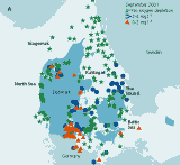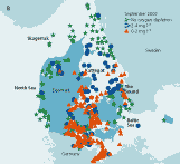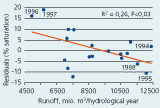
| Map of Danish marine waters | ||
| Figures 2.26 Oxygen depletion in Danish and neighbouring waters within September 2001 (A) and 2002 (B). Swedish and German monitoring data are included. |
| September 2001 |
 |
| September 2002 |
 |
| Figure 2.27 Residuals between modelled and observed oxygen saturation (mean May-September per year) as a function of (A) the runoff, and (B) the N-load during the previous hydrological year (June-May). The two hydrological years with lowest and the three hydrological years with highest runoff are indicated. |
| Runoff |
 |
| N-load |
 |
|
Oxygen depletion
Nutrient enrichment/eutrophication may give rise to an increased rate of oxygen consumption, decreased oxygen concentrations and an increased frequency of oxygen depletion. In Denmark oxygen depletion is defined as oxygen concentrations below 4 mg l-1 (2.8 ml l-1), and severe (acute) oxygen depletion as below 2 mg l-1 (1.4 ml l-1). The observed oxygen concentrations in September 2001 and 2002 are shown in Figure 2.26.
Analyses of long term development in bottom water oxygen concentrations during late summer–autumn in the Kattegat-Belt Sea from the 1970s to late 1980s/1990s (Table 2.7) show significant decreases in all areas with a stratified water column, especially from the mid 1970s to the late 1980s. In the period 1989–2001 no general development in the summer-autumn bottom water minimum oxygen concentration was observed. However, a tendency for a rise in minimum oxygen concentration in spring (April-June) has been found (Hansen et al. 2000, Ærtebjerg et al. 2002).
Oxygen depletion only occurs in stratified water columns where stratification prevents oxygen-rich surface waters to mix to the bottom. The oxygen concentration close to the sea bottom in stratified waters depends on two processes each varying in time and space: the consumption rate, which is mainly dependent on the supply of organic matter and the temperature, and the oxygen supply rate, which is mainly dependent on wind conditions. Therefore, it is difficult to assess, if a particular oxygen depletion incident is due to increased consumption rate or decreased supply rate of oxygen, and thus to relate the oxygen concentrations to nutrient loads.
Therefore, oxygen level in the bottom layer (20–40 m) in the southern Kattegat and Belt Sea was modelled as a function of a temperature dependent gross oxygen consumption rate, water temperature and residence time. The later defined as the time since the bottom water advected below the pycnocline. The residuals between modelled and observed oxygen saturation was interpreted to arise from inter-annual variations in the availability of organic matter for respiration (Henriksen et al. 2001). In the period 1982–2000 the residuals (mean May–Sept.) correlated significantly to the runoff and N-load in the previous hydrological year (June–May). High runoff and load generally corresponded to lower oxygen levels than modelled, and low runoff and load as in 1996-1997 corresponded to higher oxygen levels than modelled (Figure 2.27). Hansen et al. (1995) made a scenario analysis of effects of reduced nitrogen input on oxygen conditions in the Kattegat and Belt Sea. They concluded, that the nationally and internationally agreed nitrogen load reductions would significantly improve the oxygen situation, but to reach the oxygen level in the 1950s it would probably be necessary also to lower the atmospheric nitrogen deposition.
Most of the Danish estuaries-coastal waters are shallow, and the wind
can easily mix the water column to the bottom. Stratification only occurs
periodically during calm and warm periods building up a thermocline, or
by inflow of saline bottom water creating a temporary halocline. In a
detailed study of a shallow Danish estuary (Skive Fjord/Lovns Bredning)
it was possible to separate the effect of meteorological forcing (wind,
solar radiation) and nutrient load on oxygen depletion in bottom water.
During summer periods of stratification oxygen saturation could be attributed
to the time elapsed after the onset of stratification and the accumulated
nitrogen loading 10 months prior to measurement. Using 10 years meteorological
data and an empirical model, it was calculated that a 25% reduction in
nitrogen loading would reduce the number of days with severe oxygen depletion
(<15% saturation) by more than 50% (Møhlenberg
1999).
Published statistical significant results of analyses of the development in bottom water oxygen concentrations late summer – autumn in the Kattegat-Belt Sea from the 1970s to late 1980s/1990s.
| Area | Period | Annual Change | Rerence |
| Kattegat | 1971-82/90 | -0.05-0.1 ml l-1 | Andersson & Rydberg 1988, 1993 |
| Kattegat NE |
1970-95 1975-88 |
-0.2%saturation -1.16% saturation |
HELCOM 1996 Agger & Ærtebjerg 1996 |
| Kattegat S | 1975-88 | -1.17-1.41% saturation | Agger & Ærtebjerg 1996 |
| The Sound | 1970-95 1975-88 | -0.5% saturation -1.10% saturation |
HELCOM 1996 Agger & Ærtebjerg 1996 |
| Great Belt | 1974-95 | -0.7% saturation | HELCOM 1996 |
| Little Belt S | 1976-97 | Decrease | Ærtebjerg et al. 1998 |
| Fehmarn Belt | 1975-97 1979-93 1975-88 |
Decrease -0.5% saturation -2.97% saturation |
Ærtebjerg
et al. 1998 HELCOM 1996 Agger & Ærtebjerg 1996 |
| Kiel Bight | 1957-86 1976-90 |
-0.10-0.11 ml l-1 -0.15 ml l-1 |
Babenerd 1991 Weichart 1992 |
| | Top | |
| Next
| |







